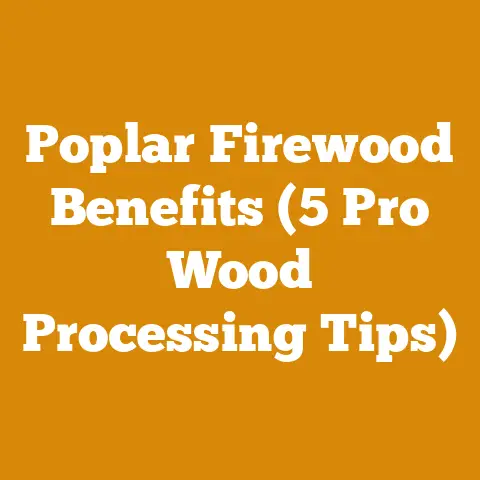Is It Safe to Burn Pressure Treated Wood? (5 Toxic Risks)
Have you ever stood before a crackling fire, mesmerized by the dancing flames, and wondered about the wood fueling its warmth? I have, countless times. As someone deeply immersed in the world of wood processing, from felling trees with my trusty chainsaw to meticulously stacking firewood, I’ve learned a thing or two about what burns best – and what you should absolutely avoid. One question that keeps popping up, and rightfully so, is: “Is it safe to burn pressure-treated wood?” The short answer is a resounding NO. But the reasons why, and the potential consequences, are far more complex and frankly, a little scary. Let’s dive deep into the toxic risks associated with burning pressure-treated wood, and how to ensure your fires are safe and sustainable.
Is It Safe to Burn Pressure Treated Wood? (5 Toxic Risks)
Pressure-treated wood, ubiquitous in outdoor construction, undergoes a chemical process to resist rot, decay, and insect infestation. These chemicals, while effective for their intended purpose, are not meant to be incinerated. Burning pressure-treated wood releases highly toxic substances into the air, posing significant risks to human health and the environment. It’s a bit like opening Pandora’s Box – once those toxins are released, they’re hard to contain.
Understanding Pressure Treatment: A Primer
Before we delve into the risks, let’s understand what pressure treatment actually entails. The process involves forcing chemical preservatives deep into the wood fibers under high pressure. This makes the wood resistant to the elements and biological threats. However, the very chemicals that provide this protection are the source of the danger when burned.
Types of Preservatives Used
The preservatives used in pressure-treated wood have evolved over time. The most common types you’ll encounter include:
- Chromated Copper Arsenate (CCA): This was the industry standard for decades. While phased out for residential use in 2003 due to arsenic concerns, you might still encounter CCA-treated wood in older structures.
- Alkaline Copper Quaternary (ACQ): A common alternative to CCA, ACQ uses copper and quaternary ammonium compounds to protect the wood. While less toxic than CCA, it still poses risks when burned.
- Copper Azole (CA): Another CCA alternative, CA uses copper and azole compounds for wood preservation. Similar to ACQ, it’s less toxic than CCA but still unsafe to burn.
Risk 1: Arsenic Exposure (CCA-Treated Wood)
The most significant risk associated with burning CCA-treated wood is arsenic exposure. Arsenic is a known carcinogen, meaning it can cause cancer. When burned, CCA releases arsenic trioxide, a highly toxic compound that can be inhaled or ingested.
Health Effects of Arsenic Exposure
- Short-term exposure: Can cause nausea, vomiting, abdominal pain, and diarrhea.
- Long-term exposure: Linked to various cancers, including lung, bladder, and skin cancer. It can also cause cardiovascular problems, neurological damage, and developmental issues in children.
- Inhalation: Breathing in arsenic-laden smoke can lead to respiratory irritation, chronic cough, and increased risk of lung cancer.
- Ingestion: Ash from burned CCA-treated wood can contaminate soil and water, potentially leading to arsenic ingestion.
Data and Statistics on Arsenic Toxicity
The World Health Organization (WHO) considers arsenic a major public health concern. Studies have shown that even low-level arsenic exposure can have detrimental health effects over time. For example, a study published in Environmental Health Perspectives found a correlation between arsenic exposure and increased risk of cardiovascular disease.
- WHO: The WHO sets a provisional guideline value of 0.01 mg/L for arsenic in drinking water.
- EPA: The U.S. Environmental Protection Agency (EPA) has established a maximum contaminant level (MCL) of 0.010 mg/L for arsenic in drinking water.
- Research: Research indicates that exposure to arsenic levels above these guidelines, even through inhalation of smoke from burning treated wood, can significantly increase health risks.
Risk 2: Copper Toxicity (ACQ and CA-Treated Wood)
While ACQ and CA-treated wood don’t contain arsenic, they do contain copper, which can also be toxic when inhaled or ingested in sufficient quantities. Burning these types of treated wood releases copper oxide particles into the air.
Health Effects of Copper Exposure
- Short-term exposure: Can cause respiratory irritation, nausea, vomiting, and diarrhea.
- Long-term exposure: Can lead to liver damage, kidney damage, and neurological problems.
- Inhalation: Breathing in copper oxide particles can irritate the lungs and exacerbate respiratory conditions like asthma.
- Ingestion: Ash from burned ACQ or CA-treated wood can contaminate soil and water, potentially leading to copper ingestion.
Data and Statistics on Copper Toxicity
Copper is an essential nutrient in small amounts, but excessive exposure can be harmful. The EPA has established regulations to limit copper levels in drinking water to protect public health.
- EPA: The EPA’s action level for copper in drinking water is 1.3 mg/L.
- Research: Studies have shown that chronic exposure to copper levels above this action level can lead to adverse health effects, particularly in vulnerable populations like children and the elderly.
Risk 3: Dioxin and Furan Formation
Burning pressure-treated wood can also lead to the formation of dioxins and furans, highly toxic chemicals that are known carcinogens and endocrine disruptors. These compounds are formed during incomplete combustion of organic materials, especially in the presence of chlorine (which can be present in some treated wood formulations or from contaminants).
Health Effects of Dioxin and Furan Exposure
- Short-term exposure: Can cause skin rashes, chloracne (a severe acne-like condition), and liver abnormalities.
- Long-term exposure: Linked to various cancers, immune system suppression, reproductive problems, and developmental issues.
- Environmental Persistence: Dioxins and furans are persistent organic pollutants (POPs), meaning they persist in the environment for long periods and can bioaccumulate in the food chain.
Data and Statistics on Dioxin and Furan Toxicity
Dioxins and furans are among the most toxic chemicals known to science. The WHO has established a tolerable monthly intake (TMI) for dioxins and dioxin-like PCBs.
- WHO: The WHO’s TMI for dioxins and dioxin-like PCBs is 70 picograms toxic equivalent (TEQ) per month.
- Research: Studies have shown that even low-level exposure to dioxins and furans can have significant health effects, particularly in children. For example, a study published in Environmental Health Perspectives found a correlation between prenatal exposure to dioxins and reduced cognitive function in children.
Risk 4: Air Pollution and Respiratory Problems
Burning any type of wood releases particulate matter (PM) into the air, but burning pressure-treated wood releases even more harmful pollutants. These pollutants can exacerbate respiratory problems and contribute to air pollution.
Health Effects of Air Pollution
- Short-term exposure: Can cause coughing, wheezing, shortness of breath, and eye irritation.
- Long-term exposure: Linked to chronic respiratory diseases like asthma and bronchitis, as well as cardiovascular problems and lung cancer.
- Vulnerable Populations: Children, the elderly, and people with pre-existing respiratory conditions are particularly vulnerable to the health effects of air pollution.
Data and Statistics on Air Pollution
Air pollution is a major public health concern worldwide. The WHO estimates that air pollution causes millions of premature deaths each year.
- WHO: The WHO estimates that 4.2 million premature deaths each year are attributable to ambient (outdoor) air pollution.
- EPA: The EPA has established National Ambient Air Quality Standards (NAAQS) for particulate matter and other pollutants to protect public health.
- Research: Studies have consistently shown a link between air pollution and increased risk of respiratory and cardiovascular diseases.
Risk 5: Soil and Water Contamination
The ash from burned pressure-treated wood contains toxic chemicals that can contaminate soil and water. If the ash is disposed of improperly, these chemicals can leach into the environment and pose a risk to human health and ecosystems.
Environmental Effects of Soil and Water Contamination
- Soil Contamination: Can harm plants and animals that come into contact with the contaminated soil. It can also affect soil fertility and water infiltration.
- Water Contamination: Can contaminate groundwater and surface water, posing a risk to drinking water sources and aquatic life.
- Bioaccumulation: Toxic chemicals can bioaccumulate in the food chain, meaning they become more concentrated in organisms higher up the food chain.
Data and Statistics on Soil and Water Contamination
Soil and water contamination is a widespread environmental problem. The EPA has established regulations to protect soil and water quality and to clean up contaminated sites.
- EPA: The EPA’s Superfund program is responsible for cleaning up some of the most contaminated sites in the United States.
- Research: Studies have shown that soil and water contamination can have long-lasting effects on ecosystems and human health.
Identifying Pressure-Treated Wood: What to Look For
Okay, so we know it’s bad to burn, but how do you even know if wood is pressure-treated? It’s not always obvious, especially with older pieces. Here’s what I look for:
- Color: Pressure-treated wood often has a greenish or brownish tint due to the chemicals used in the treatment process. However, this color can fade over time, especially with exposure to sunlight.
- Stamps or Markings: Look for stamps or markings on the wood that indicate it is pressure-treated. These markings may include abbreviations like “CCA,” “ACQ,” or “CA,” as well as information about the level of treatment and the intended use of the wood.
- End Tags: Some pressure-treated wood products have end tags attached that provide information about the treatment process and safety precautions.
- Drill Marks: Pressure-treated wood often has small drill marks where the chemicals were injected into the wood.
- Age: If you’re dealing with older wood, it’s more likely to be CCA-treated. Wood treated before 2003 is a prime suspect.
Safe Alternatives: What Can You Burn?
Now that we’ve established what not to burn, let’s talk about safe alternatives. Burning the right type of wood is crucial for both your health and the environment.
- Seasoned Hardwoods: These are your best bet. Oak, maple, ash, birch – they burn hot and long. Seasoning is key; it means the wood has been allowed to dry for at least six months, ideally a year. This reduces moisture content, leading to a cleaner, more efficient burn. I always tell people, “Green wood hisses; seasoned wood sings.”
- Softwoods (with caution): Pine, fir, and spruce can be burned, but they tend to burn faster and produce more smoke and creosote. If you’re going to burn softwoods, make sure they are well-seasoned and use them sparingly.
- Kiln-Dried Wood: This wood has been dried in a kiln to a low moisture content, making it an excellent choice for burning. It burns cleanly and efficiently, producing minimal smoke.
The Cost of Ignorance: A Personal Anecdote
I’ll never forget the time a friend of mine, new to the world of wood stoves, unknowingly burned some pressure-treated scraps in his fireplace. The acrid smell filled his house, and everyone experienced headaches and nausea. He ended up having to call a professional to clean his chimney, which was coated in a thick layer of toxic creosote. The cost? Several hundred dollars, plus the potential long-term health risks. It was a costly lesson learned.
Proper Disposal of Pressure-Treated Wood
If you have pressure-treated wood that you need to get rid of, don’t burn it. Instead, dispose of it properly at a designated landfill or recycling center.
- Landfills: Most landfills accept pressure-treated wood. Contact your local landfill to inquire about their disposal policies and fees.
- Recycling Centers: Some recycling centers specialize in recycling wood products, including pressure-treated wood. These centers may be able to reuse the wood in other applications.
- Never Bury or Burn: Never bury pressure-treated wood in your backyard or burn it in a fire pit or wood stove. This can contaminate the soil and air, posing a risk to human health and the environment.
The Economics of Safe Firewood: A Cost Breakdown
Now, let’s talk about the economics of safe firewood. I know that finding affordable firewood can be a challenge, but it’s important to prioritize safety over cost. Here’s a breakdown of the costs involved:
- Purchasing Firewood: The cost of firewood varies depending on the type of wood, the quantity, and the location. On average, a cord of seasoned hardwood can cost anywhere from $200 to $500. Softwoods are typically cheaper, but they don’t burn as efficiently.
- Harvesting Your Own Firewood: If you have access to a wooded area, you can harvest your own firewood. However, this requires time, effort, and the right equipment, including a chainsaw, axe, and wood splitter. You’ll also need to factor in the cost of fuel, oil, and maintenance for your equipment.
- Seasoning Firewood: Seasoning firewood takes time, but it’s essential for a clean and efficient burn. You’ll need a dry, well-ventilated area to store your firewood for at least six months, ideally a year.
- Storage: Proper storage is crucial for keeping your firewood dry and protected from the elements. You’ll need a woodshed or a covered area to store your firewood.
A Case Study: Cost Comparison of Firewood Options
Let’s compare the cost of purchasing firewood versus harvesting your own:
| Option | Cost ,
Important Considerations:
- Local Regulations: Always check with your local authorities for regulations regarding firewood harvesting and burning. Some areas may have restrictions on the type of wood you can burn or the time of year you can burn it.
- Permits: In some areas, you may need a permit to harvest firewood from public lands.
- Safety Gear: When harvesting your own firewood, always wear appropriate safety gear, including a hard hat, eye protection, hearing protection, and gloves.
- Chainsaw Safety: If you’re using a chainsaw, be sure to follow all safety precautions and wear appropriate chainsaw safety gear.
Budgeting for Firewood: Tips and Tricks
Here are some practical tips for budgeting for firewood:
- Buy in Bulk: Buying firewood in bulk is typically cheaper than buying it in smaller quantities.
- Shop Around: Compare prices from different firewood suppliers to find the best deal.
- Harvest Your Own: If you have the time and resources, harvesting your own firewood can save you money.
- Season Your Own: Seasoning your own firewood can save you money compared to buying pre-seasoned wood.
- Consider Alternatives: If firewood is too expensive, consider alternative heating options, such as a propane heater or an electric fireplace.
The Environmental Impact: Burning Responsibly
Burning wood, even the right kind, has an environmental impact. Here’s how to minimize it:
- Burn Seasoned Wood: This reduces smoke and emissions.
- Use an EPA-Certified Stove: These stoves are designed to burn wood more efficiently and produce less pollution.
- Don’t Overfire: Overfiring your stove can lead to incomplete combustion and increased emissions.
- Consider Renewable Energy: Explore alternative heating options, such as solar or geothermal, to reduce your reliance on wood.
Calculating Wood Volume: Cords, Board Feet, and Beyond
Understanding how wood is measured is crucial for budgeting. Here’s a quick rundown:
- Cord: A cord is a stacked pile of wood measuring 4 feet high, 4 feet wide, and 8 feet long, totaling 128 cubic feet.
- Board Foot: A board foot is a unit of measurement for lumber, equal to 1 inch thick, 12 inches wide, and 12 inches long.
- Estimating Volume: You can estimate the volume of logs using various formulas, such as the Doyle Log Rule or the International 1/4-inch Log Rule. These formulas take into account the diameter and length of the log to estimate the amount of usable lumber.
Drying Time Estimation: The Moisture Content Factor
The moisture content of wood significantly affects its burning efficiency. Here’s how to estimate drying time:
- Moisture Content: Freshly cut wood can have a moisture content of 50% or higher. Seasoned firewood should have a moisture content of 20% or less.
- Drying Time: The drying time for firewood depends on the type of wood, the climate, and the storage conditions. In general, hardwoods take longer to dry than softwoods.
- Estimating Drying Time: You can estimate the drying time using various formulas and guidelines. For example, a general rule of thumb is that hardwoods take about a year to season, while softwoods take about six months.
Challenges Faced by Small-Scale Loggers and Firewood Suppliers
Small-scale loggers and firewood suppliers face numerous challenges, including:
- Fluctuating Timber Prices: Timber prices can fluctuate significantly depending on market conditions, making it difficult to plan and budget.
- Equipment Costs: Logging and firewood processing equipment can be expensive to purchase and maintain.
- Labor Costs: Hiring skilled labor can be a significant expense.
- Permitting and Regulations: Complying with permitting and regulations can be time-consuming and costly.
- Competition: Small-scale loggers and firewood suppliers often face stiff competition from larger companies.
Compelling Phrases and Actionable Takeaways
- “Don’t gamble with your health; burn responsibly.”
- “Seasoned wood: the key to a warm heart and a clean chimney.”
- “Know your wood, know your risks.”
- “Investing in safe firewood is an investment in your well-being.”
Actionable Takeaways and Next Steps
- Identify any pressure-treated wood on your property and dispose of it properly.
- Source safe, seasoned firewood from a reputable supplier.
- Consider harvesting your own firewood if you have the time and resources.
- Invest in an EPA-certified wood stove for a cleaner and more efficient burn.






